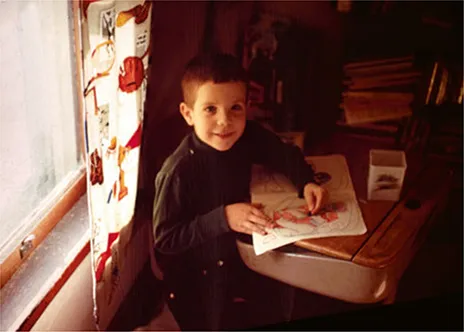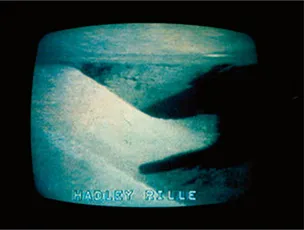
This is a test
- 320 pages
- English
- ePUB (mobile friendly)
- Available on iOS & Android
eBook - ePub
Book details
Book preview
Table of contents
Citations
About This Book
In Two-Dimensional Man, Paul Sahre shares deeply revealing stories that serve as the unlikely inspiration behind his extraordinary thirty-year design career. Sahre explores his mostly vain attempts to escape his "e;suburban Addams Family"e; upbringing and the death of his elephant-trainer brother. He also wrestles with the cosmic implications involved in operating a scanner, explains the disappearance of ice machines, analyzes a disastrous meeting with Steely Dan, and laments the typos, sunsets, and poor color choices that have shaped his work and point of view. Two-Dimensional Man portrays the designer's life as one of constant questioning, inventing, failing, dreaming, and ultimately making.
Frequently asked questions
At the moment all of our mobile-responsive ePub books are available to download via the app. Most of our PDFs are also available to download and we're working on making the final remaining ones downloadable now. Learn more here.
Both plans give you full access to the library and all of Perlego’s features. The only differences are the price and subscription period: With the annual plan you’ll save around 30% compared to 12 months on the monthly plan.
We are an online textbook subscription service, where you can get access to an entire online library for less than the price of a single book per month. With over 1 million books across 1000+ topics, we’ve got you covered! Learn more here.
Look out for the read-aloud symbol on your next book to see if you can listen to it. The read-aloud tool reads text aloud for you, highlighting the text as it is being read. You can pause it, speed it up and slow it down. Learn more here.
Yes, you can access Two-Dimensional Man by in PDF and/or ePUB format, as well as other popular books in Design & Graphic Design. We have over one million books available in our catalogue for you to explore.
Information
Topic
DesignSubtopic
Graphic DesignPART I
(Chaos)

The Refrigerator
I was raised in a mind-numbing suburb in upstate New York, the third of four, aka the middle child, aka forgettable (3). Unlike my siblings, I wasn’t born with a built-in “look at me” trait. I realized early on that if I was going to get any attention, I was going to have to develop something. This isn’t to say that I was neglected. There was yelling, constipation, groundings, bed-wettings, hernias, bloody noses, stitches, and masturbation, but there was also a lot of love. My parents were not shy about showing affection for us and for each other. They were just outnumbered; that, and the competition was fierce.
My father had been in the Air Force, and, as a consequence, we did a number of things military style, despite the fact that we were all so different from one another. Like my brothers, I had a crew cut until my seventh birthday. My father would clear out a spot in the living room, take out his electric razor, set it on the shortest setting, and one by one we would be sheared, rubbing our stubbly heads as we left the chair. My mom stuck with meals best prepared in bulk. Most of these meals were cooked in a big pot and served with a ladle: beans and franks, tuna casseroles, and goulash. We ate a lot of meatloaf.
Greg was the oldest (1). He had his own bedroom. He was deaf and had a learning disability due to a case of German measles my mom contracted when she was pregnant. To say he needed more attention than the rest of us is an understatement. As a consequence, he created, through no fault of his own, a domino effect that reverberates through the family to this day. There are many examples I could give to illustrate this, and the first that comes to mind is that my name is Dwayne. Around the second grade, my parents decided that Greg would never be able to pronounce Dwayne. He could pronounce my middle name, however, so Paul it was.
My sister, Sharon, was next (2). She was the only girl. This meant she also got special treatment, ostensibly in the form of a gender quarantine.
She rode in the front seat during family trips. When (not if) things escalated in the back seat, Dad would threaten to “pull over.” If my brothers and I kept at it, the car would slow down. “WE’LL STOP! WE’LL STOP!” we yelled, but once such an event was set in motion there was no turning back. The car would stop, Dad would reach into the back seat, and my brothers and I hit the deck, trying, in vain, to avoid the hand. I always imagined what this would look like to passersby. From the outside, the car would be bouncing, windows steaming up, with muffled screams coming from the inside of the station wagon. My sister, who would watch this unfold from the front seat, just shook her head. She was sometimes strategically placed in the back seat as a way of separating us.
Sharon never got a crew cut.
Angus was the youngest (4), my roommate until I went to college. He liked to throw frogs into the busy street in front of our house in Johnson City and watch them get run over. Once you hear the sound of a fat toad exploding under a car tire going thirty-five miles per hour, you never forget it. Angus was spanked a lot.
As the youngest, Angus would have stood out for that reason alone, but he was also what my dad referred to as a “towhead,” meaning he had blond, almost white, hair; this in a family with predominately dark hair. Strangers would frequently ask if he was albino. One of my dad’s favorite quips involved Angus being “delivered” by the mailman.
As Angus moved on from frogs to spray-painting the neighbor’s trees, my parents took him to see a child psychiatrist. He was diagnosed as hyperactive and put on medication. His behavior issues worsened, so that experiment didn’t last long.
We were two years apart and I was his defacto protector, at least where the outside world was concerned. It was only at home that I would throw him under the bus, mainly so I didn’t get in trouble for something he started.
Despite all of it, Angus was a very likeable kid, an extrovert. I was the opposite: shy, introverted. Angus always made friends before I did. If we were somewhere new, he would be playing with every kid on the playground and I would be off on my own. This held true for us as adults, too, only for Angus those playgrounds turned into bars.

In the middle of all this was me, making rumbling noises with my mouth as I pushed my big yellow Tonka truck around in the backyard. Scooping and dumping, scooping and dumping. I would never be the oldest or the youngest or a girl. Furthermore, I could never be better than my brothers at being learning disabled, deaf, or getting into trouble. This left only the refrigerator. Before I knew much, I knew that a finger painting, crayon scribble, or collage with glitter and feathers displayed on the refrigerator meant praise. We all had artwork on the fridge early on, but as we got older I continued to draw. I got better. The refrigerator became my Ferus Gallery.
I Saw It on TV
Being a five-year-old in the late ’60s was confusing and often terrifying. Protests. Strikes. Marches. Riots. Assassinations. War. I was insulated from all of it, except for the images that flickered in black-and-white on our Magnavox television set. Dad tuned in to the CBS Evening News every night. The program consisted of a flood of strange words spoken by a man seated in front of a screen. He didn’t encourage me to watch the news, but he didn’t discourage me either, even if he had to answer questions like “Who are the Viet Cong?” or “What is a body bag?” or “Why would someone shoot that man?” It took me a while, but I eventually learned to avoid the living room from 6:30 to 7 PM.

My father was an aerospace engineer, so I made an exception (as did the rest of the family) for anything related to the Apollo space missions. We watched it all like church. “Daddy, what is yaw?” Questions like this were certainly easier for him to handle.
Old Spice G.I. Joe
The Sahre family drove. All six of us would cram into the car for vacations and visits to relatives. These trips were typically between two and three hours in duration (not counting our cross-country trip to Disneyland in the summer of 1974; that was an outlier). Most of the time, we would be driving north to Herkimer to visit Nana and Uncle Carl, or south to Lakehurst, New Jersey, to see Grandma and Grandpa Schoop. For years they operated a yarn shop out of their big house on Route 10, in Morris Plains, but they had since retired to an elderly community farther south.

Lakehurst was where the German zeppelin Hindenburg exploded in a fire-ball in 1937. We visited the naval station on more than one occasion, standing in the field where the disaster happened, touring the huge hangar. We frequently drove to air shows and aircraft museums anyway, so these trips to see the in-laws were two-for-ones as far as Dad was concerned.
Paul Schoop was a Swiss dairy farmer who immigrated to the United States in 1926. My mom would tell us stories of him skiing between farms making milk deliveries as a teenager, or of his forcing her to learn to play the accordion growing up. She also claimed he could yodel, but fortunately I never witnessed this. He left his homeland to look for work and to start a new life.
My mother always suggested that he had a case of wanderlust. I could never reconcile that last part with the person I knew. He didn’t seem like a restless spirit. My grandfather was stern, reserved, and predictable, like his Swiss watch. He would sit in his La-Z-Boy recliner for hours in the same room with you, watching The Lawrence Welk Show, and never say a word. My grandfather was intimidating, especially when I was younger. His Germanic accent didn’t help. Kid impressions aside, he was a gentle man—though there was that time in the Toys“R”Us parking lot when he climbed over two rows of car seats to whack Angus after he talked back (none of us thought he could move that fast). But mostly he tolerated us. Grandma Schoop was the affectionate one.
Now that I’m a father, I have a better appreciation for how disruptive our visits must have been. Theirs was a quiet house in a neighborhood of quiet houses. Not only did the Sahre family never fly, we never stayed in hotels, either. Our visits were more like invasions: We slept on cots, dug holes in the yard, and left toys strewn everywhere. We would leave, and then a few weeks later the process would start all over again. My grandparents must have spent all the time in between our visits rebuilding their defenses.
Grandpa Schoop had a distinctive smell—he wore Old Spice. I liked to play with the iconic cone-shaped bottle, with its etching of an old-time sailing vessel and script typeface, but only after locking the door. You never wanted to be caught playing with anything in the bathroom.
One day, I was running around in the yard and I ducked inside to take a piss when I noticed the head of one of our G.I. Joes sitting atop the bottle.

My first thought was one of my brothers had done this and that I should remove it before our heads started to roll. But when I brought them inside to see it, neither of them fessed up. They shrugged their shoulders, as confused as I was, and we all went back outside.
Although seemingly out of character, it was Grandpa Schoop who had reappropriated the head. He must have found it lying around in the aftermath of one of our visits and noticed that the neck diameter was the same as the cap on his cologne. I like to imagine his satisfaction when he placed it on top of the bottle and it fit so perfectly, as if the bottle was designed to be anthropomorphized. He transferred that G.I. Joe head from empty to full bottle until the day he died.
By combining two things that were designed for other purposes, he had created a design object, something Duchamp would have appreciated. It also demonstrated a playfulness and sense of humor that I didn’t think he had. This new object clearly had meaning to him (it reminded him of us), but it also communicated something. Maybe it was a warning about what would happen if we left our toys lying around, or maybe it was a sign that we weren’t such a nuisance after all, even if he never put that into words.
St. Mary’s
While the rest of us were walking to school down the block, Greg was flying (with Dad) to St. Mary’s School for the Deaf in Buffalo. It was strange not having him around. And quiet. Because of Greg, everything in the house was at full volume, from our conversations to the TV. He had a hearing aid that helped him hear just enough to process some of the world around him. The earliest device had a molded earpiece connected by a curly wire to a silver box that was strapped to his chest. He was always adjusting it, trying to eliminate the acoustic feedback, and every time he did this, his hearing aid emitted a loud modulating whistle.
He had a very specific wa...
Table of contents
- Cover
- Title Page
- Dedication
- Table of Contents
- Apologies to J. Müller-Brockmann
- Prologue: Demon Eating Human Flesh
- PART I (Chaos)
- PART II (Order)
- PART III (Entropy)